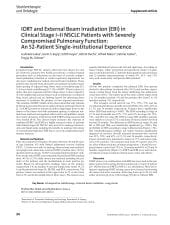overview
In limited stage NSCLC surgery offers the best chance for cure [1]. However, patients who would not tolerate a radical surgical procedure such as lobectomy on the basis of severely compromised pulmonary function or cardio respiratory impairment are also poor candidates for radical external beam irradiation. These patients may benefit from alternative procedures that allow maxi-mum sparing of adjacent lung tissue such as brachytherapy [10, 11], stereotactic radiotherapy [12–15] or IORT. There is clear evidence that loco-regional control in lung cancer is dose related [2, 3], but neighboring normal tissues such as ipsilateral or collateral lung, heart, spinal cord are limiting factors for delivering doses necessary to eradicate the primary or loco-regional metastases. The rational of IORT, builds on the observation that only patients in whom local control has been achieved had a prolonged survival [2, 3]. IORT permits to selectively deliver high single doses to the tumor or the tumor bed with maximum sparing of adjacent normal tissue and has been applied with curative and palliative intent in a variety of tumors. Experience with IORT in lung cancer is still very limited [4–9]. The current study evaluates the outcome of combined IORT and EBI in a highly selected cohort of patients with clinical stage I-II NSCLC who were fit to undergo thoracotomy and lymph node sampling but unable to undergo lobectomy or conventional high dose EBI due to severely compromised pulmonary function.
METHODS AND MATERIALS
Fifty-two patients (14 females; 38 males) between 49 and 80 years of age (median: 65) with limited pulmonary reserve (median FEV1: 1.3) who were able to undergo thoracotomy and mediastinal lymph node dissection received IORT (median dose: 20 Gy; median electron energy: 12 MeV) encompassing the primary only. Four weeks after IORT conventionally fractionated EBI (median dose: 46 Gy at 2 Gy daily doses) was initiated including the primary or the primary and the mediastinum in node positive patients. Based on intraoperative findings (sizes of the primary ranged from 2-8 cm; median: 4 cm) and lymph node status 19, 21, 6, and 6 patients had stage IA, IB, IIB, and IIIA, respectively. The primary tumor was located in the upper lobe in 31, in the lower lobe in 18, and in the middle lobe in three cases. The tumors were equally distributed between the left and right lung. According to tumor biopsy, either performed preoperatively under CT-guidance or intraoperatively, 27 patients had squamous cell carcinoma and 25 patients adenocarcinoma of which 8%, 61%, and 31% were well, moderately, and poorly differentiated.
RESULTS
All but two patients completed the planned EBI. One patient elected to discontinue treatment after 26 Gy and another experienced a lethal bleed from his tumor infiltrating the pulmonary vessel after 28 Gy. The follow-up of the entire cohort ranges from 2 to 116 months (median: 19) and for patients alive from 2 to 116 months (median: 18), respectively.
CONCLUSION
The use of IORT to deliver high single fraction doses precisely limited to the tumor and the possibility to tailor subsequent moderate-dose EBI according to the spread of disease offers a potentially curative therapy in patients who are unable to undergo radical surgery or radical EBI due to their severe functional impairment. The results obtained are promising.
